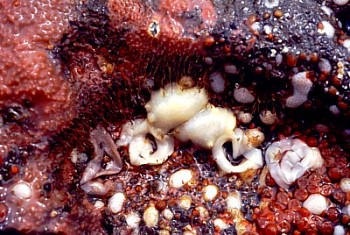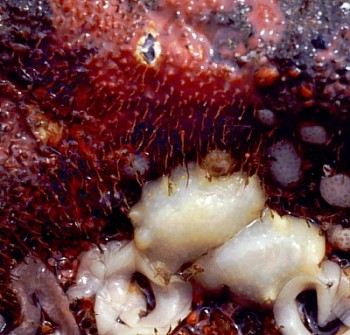Sponge prey of Cadlina modesta
June 16, 2000
From: Jeff Goddard


Hi Bill,
Here is a photo of Cadlina modesta on one of the sponges it eats, along with some information on its diet, to go with your recent listing of this species in the Forum.
Cadlina modesta preys exclusively on the dendroceratid sponges, Aplysilla glacialis, and Halisarca sp. (McDonald & Nybakken, 1978; Goddard, 1984, 1998, unpublished observations). In laboratory preference tests in a modified Y maze, it showed a strong preference for A. glacialis over Halisarca sp. (Goddard, unpublished observations).
The photograph shows two Cadlina modesta and their egg masses on a partially grazed patch of Aplysilla glacialis. The hair-like vertical spongin fibers mark where the sponge has been grazed. Also present are the white colonies of the octocoral Alcyonium rudyi Verseveldt & van Ofwegen, 1992 (a prey species of Tritonia festiva) and the orange colored "social" ascidians Metandrocarpa taylori. Underside of an intertidal boulder, North Cove, Cape Arago, Oregon, 27 May 1985.
Interestingly, all 4 species of Cadlina known from the northeastern Pacific are known to prey on Aplysilla glacialis. Cadlina sparsa and C. flavomaculata, so far as is known, specialize on this species; as mentioned above, C. modesta prefer it; and C. luteomarginata appear to prefer it as well, but also prey on many species of spiculate sponges (McDonald & Nybakken, 1978; Goddard, 1984, 1998, 2000, unpublished observations).
References:
• Goddard, J.H.R. (1984) The opisthobranchs of Cape Arago, Oregon, with notes on their biology and a summary of benthic opisthobranchs known from Oregon. The Veliger, 27: 143-163
• Goddard, J.H.R. (1998) A summary of the prey of nudibranch molluscs from Cape Arago, Oregon. Opisthobranch Newsletter, 24: 11-14.
• Goddard, J. 2000. Sponge prey of Chromodoris macfarlandi. Opisthobranch Newsletter, 26: 9-10.
• McDonald, G.R. & J.W. Nybakken. (1978) Additional notes on the food of some California nudibranchs with a summary of known food habits of California species. The Veliger, 21: 110-119.
Best wishes,
Jeff Goddard
goddard@lifesci.ucsb.edu
Goddard, J., 2000 (Jun 16) Sponge prey of Cadlina modesta. [Message in] Sea Slug Forum. Australian Museum, Sydney. Available from http://www.seaslugforum.net/find/2579Dear Jeff,
Thanks for the photo. I've included an enlargement to show the fibres more clearly. I don't know what the chromodorids would have done without the aplysillids and there relatives. Certainly the 'softer' non-spiculate food they provide has allowed the chromodorids to either retain or develop (depending on the primitive state) quite a variety of denticles and cusps on their radular teeth, for which we as taxonomists should be enormously grateful, for the radular morphology of chromodorids is a very useful character.
Best wishes,
Bill Rudman.
Related messages
-
Cadlina modesta from British Columbia
From: Jackie Hildering, July 7, 2006 -
Cadlina modesta from British Columbia
From: Marli Wakeling, June 15, 2000
